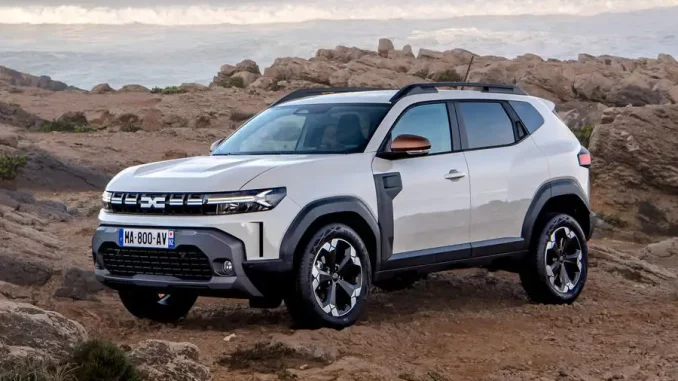
It might impart its name to a 1970s Plymouth muscle vehicle, yet the Dacia Duster is a totally different monster. Since its introduction in 2010, the Romanian Renault subsidiary’s compact SUV has established a reputation as an affordable off-road vehicle and has sold 2.2 million units in Europe. The new 2024 Duster hopes to keep up with that status while including a sound portion of style with everything else. Sadly, it will not be sold in the United States.
Fresh Design Although the previous Duster didn’t look bad, it certainly appeared to be anonymous. The headlights and taillights feature bold Y-shaped graphics in the new design, which is assertive and chiseled. Important powertrain components are shielded from the elements by front and rear skid plates, and robust wheel arches enhance the vehicle’s all-terrain appearance. The Super trim (show in these photographs) highlights copper complements.
Dacia depicts the dark trim as a “belt” that safeguards the vehicle from marks and dings, folding from the guards over the sides and up the front edge of the front entryways. This trim is molded from another material created by Dacia called Starkle, which contains up to 20 percent reused polypropylene. It is left unpainted, diminishing the vehicle’s carbon impression, and Dacia says the absence of paint makes scratches less observable. Around 20% of the plastic in the Duster is all reused, and Dacia promotes the eco-accommodating benefits of the absence of enriching chrome and genuine cowhide (likewise a helpful method for minimizing expenses). Even the user manual uses less paper now than it did in the past.
The interior of the Dacia combines a down-to-earth, low-cost aesthetic with cutting-edge features to prevent the vehicle from appearing drab. The Extreme trim’s washable fabric upholstery and rubber floor mats, of which 20% are made from recycled materials, support the visual robustness created by the use of straight lines and sharp angles. The headlights’ Y-shaped design is used for the air vents, and a 7.0-inch digital gauge cluster is added to the 10.1-inch central touchscreen that faces the driver.
In the engine
Dacia offers a variety of powertrains. The Hybrid 140 has two electric motors and a 94-horsepower 1.6-liter four-cylinder; One of them generates 49 horsepower and serves as a high-voltage starter. The Duster can drive in all-electric mode up to 80% of the time, Dacia claims, thanks to the regenerative brakes and a 1.2-kWh battery. An automatic transmission with four speeds is connected to this powertrain.
In contrast, the TCe 130 combines a 48-volt electric motor, a 0.8-kWh battery, and a turbocharged 1.2-liter three-cylinder for improved fuel economy and acceleration assistance. A six-speed manual is the main gearbox accessible on both the front-and four-wheel-drive forms of the 130. Last but not least, the Duster offers the ECO-G 100, a turbocharged 1.0-liter three-cylinder with two 13.2-gallon tanks for liquefied petroleum gas (LPG) and gasoline. The Duster can switch between LPG and gasoline at the touch of a button, according to Dacia, which claims that LPG uses 10% less carbon dioxide than gasoline.
A terrain-control feature that is included in 4×4 models and has five modes, including Snow, Mud/Sand, and Eco, will assist owners who wish to leave the pavement. This feature redistributes torque between the front and rear axles to reduce fuel consumption while still providing the necessary grip. Four-wheel-drive Dusters have 8.5 creeps of ground freedom, and the tough little ute flaunts a 31 degree approach point and 36 degree takeoff point. Additionally, there is a hill-descent control function, and the central screen displays important information that pertains to off-roading.
A roof rack that easily attaches to the roof bars and can hold up to 176 pounds is one of Dacia’s outdoor accessories. There is likewise the Rest Pack, a removable box that incorporates a crease out 6.2-by-4.2-foot bed, a collapsible table, and a stockpiling cubby. Dacia says all that’s needed is two minutes to change over the Rest Pack from a crate to a bed.
Costs haven’t been uncovered, however Dacia vows to offer “the most reasonable costs in its section.” Unfortunately, those low costs won’t ever be changed over into U.S. dollars, as the Duster will stay taboo natural product, sold chiefly in Europe and Latin America, where it has been badged as a Renault before.
Leave a Reply